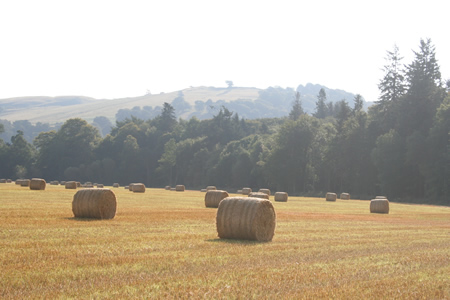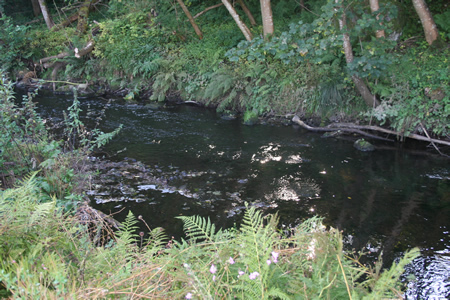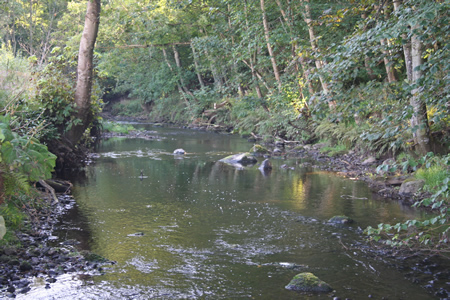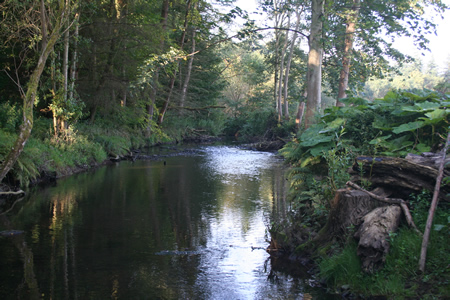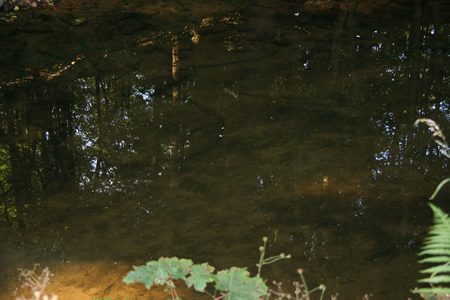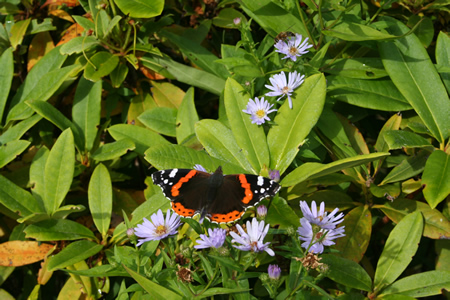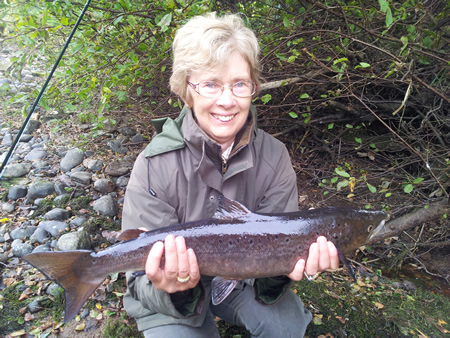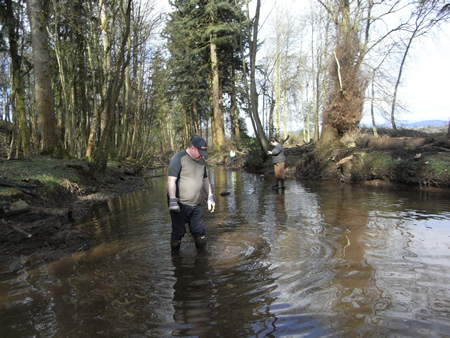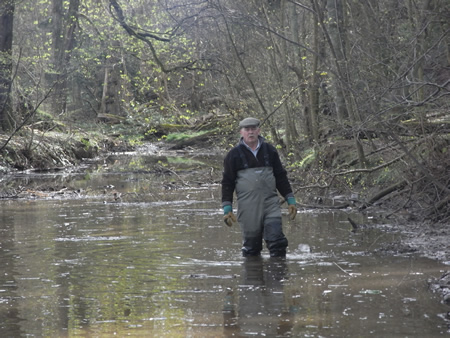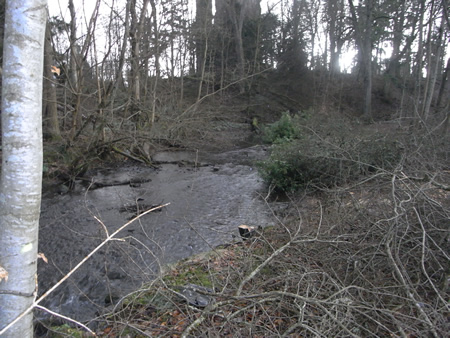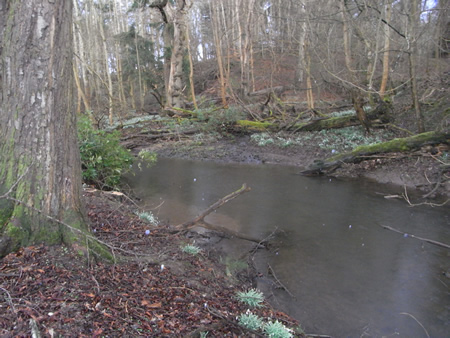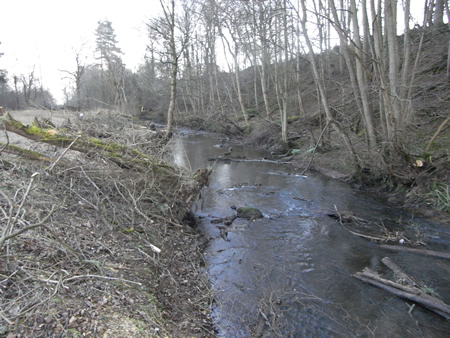These bulletin blogs represent news about Finavon and the South Esk, and my views as a riparian owner. They are not the views of any other organisation, nor are they designed to promote the interests of any individual or organisation other than Finavon Castle Water and factors affecting the fishery. Tony Andrews
Today was one of those September mornings that confirm childhood memories of golden autumn days. In the 1950s there were no high-roll bales of straw after the barley harvest. At that time the mechanised baler produced a rectangular bale that could easily be lifted by one person. But I rather like the haphazard jigsaw of the 6’0” high-roll bales in the harvested fields, even if it is impossible to lift them manually – or is it? Is there some giant of a farmer’s son somewhere in Aberdeenshire or Angus who routinely lifts and carries the huge bales from the fields to the steading?
This is the view looking south across the big field towards the Lemno Burn and the policy woodlands that line its banks. This is the section of the Lemno discussed in this bulletin blog.
So, today was a sunlit autumn Sunday, and I decided to extend the dogs’ constitutional with a wander up the Lemno Burn, which was very low after our long summer of spates. I wanted to see how the channel downstream of the A90 had developed since the volunteer day on 1st April, and what I saw surprised and delighted me.
Low water stickle in the Lemno Burn just upstream from the Red Brae
On first inspection you might think that the differences between now and a year ago are marginal: there is still far too much silt in the long flat section 300 metres upstream of the Red Brae, but below that there is now plenty of gravel exposed by healthy streams, riffles and stickles. While the gravel is still covered with algae and it is obvious that agricultural enrichment is dominant, there are places where fish might spawn. The reduced tree canopy is letting far more light in than a year ago, with the result that grasses and wildflowers are starting to re-colonise the banks.
One of the main pools (above) in the Lemno Burn in the section where the high tree canopy was reduced by thinning in the winter of 2011/12. It was in this part of the lower Lemno that I observed large numbers of salmon and sea trout parr on Sunday 23rd September.
As I walked up the left bank of the burn in the margins of the woods that define the burn’s course, peering into the water I saw small fish in every single pool. At first it was just the odd fish darting for cover as I appeared above them. But when I reached the long flat pool about half way between Red Brae and the main road (A90) I saw literally hundreds of parr, ranging in size from about 5cms to 10 or 11cms in length. In some places there were shoals of these little fish numbering 40 or 50, quite closely packed together. When disturbed they darted around the pool individually, afterwards to return to a deeper section where the shoal reformed. I was able to get quite close to a small group of fish and study them in detail with the use of my Polaroid glasses. They were certainly parr, but I have no idea whether they were salmon or trout.
Woodland pools in the lower Lemno Burn are holding large numbers of salmon and sea trout parr. The abundance of juveniles is encouraging, but as yet we do not know the ratio of salmon to sea trout. Those data would be useful in understanding the role that the Lemno Burn plays in the makeup of South Esk stocks of both species.
The same pattern repeated itself all the way up to the village. There is absolutely no point in exaggerating, and every reason to try and report as accurately as possible what I actually observed. I estimate that in the lowest 800 metres of the Lemno Burn there are at least 500 salmon and sea trout parr, and there may be more than this because my estimate is pretty conservative. These juvenile fish look to be in good condition and, judging from the quality of the riparian habitat, there is probably plenty of food available. What I cannot say, and will avoid speculating, is whether the removal of about 40% of the tree canopy and obstructions from the bed of the burn have influenced the numbers of fish using this section. In other words I have no baseline for comparison.
Above: not a very good photo of the silty bed of the pool in which I observed a large shoal of salmon or sea trout parr (probably the latter I guess).
Thinking through the implications of the various bits of information on the Lemno Burn I have recently received:
- A government scientist told me that the middle Lemno supports small numbers of very large parr (or did when it was electro fished a couple of years ago)
- The farmer at the Meadows on the King’s Burn, the only major tributary of the Lemno, described his father finding dead salmon kelts on the banks of that burn in late winter in recent years.
- My own observation on 23 September 2012 of large numbers of salmon and/or sea trout parr in the 800 metres of the Lemno Burn upstream of its confluence with the South Esk.
One could not possibly argue that all is well in the Lemno Burn, especially after the dredging vandalism carried out by the farmer to the section that runs parallel to the A90 just north of the Kirriemuir junction. There is no doubt that a lot of work needs to be done to increase the Lemno’s output of smolts. However, I am surprised and delighted to allay my concerns to some extent after what I saw today. These little fish are almost certainly in the second year of their lives and should smolt next year (April/May 2013). If, as may well be possible, the Lemno Burn is releasing two or three thousand pre-smolting parr into the South Esk each year, it is making a much better contribution to the overall stocks of salmon and sea trout of the South Esk than I had feared.
Autumn and a newly hatched Red Admiral butterfly Vanessa atlanta. The Rajah Brooke birdwing butterfly Trogonoptera brookiana is bigger, the Purple Emperor Apatura iris more regal and the Camberwell Beauty Nymphalis antiopa more exotic, but is there a more beautiful insect on earth than our very own Vanessa atlanta ? (even the Latin name is gorgeous!)
Wouldn’t it be interesting to learn what proportion of the fish I saw today were salmon or sea trout? I shall ask the Esk Trust to help us answer that question.
TA 23/9/2012
